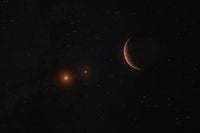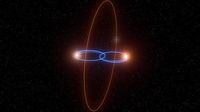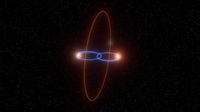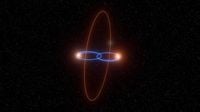NEW YORK (AP) — Scientists have reported the discovery of a new Tatooine-like planet outside our solar system, orbiting a pair of peculiar brown dwarf stars. This intriguing exoplanet, designated 2M1510 (AB) b, is located approximately 120 light years away in the constellation of Libra, and its unusual orbital path around the two brown dwarfs takes a right angle, setting it apart from other known exoplanets.
Brown dwarfs, often referred to as "failed stars," are celestial bodies that are heavier than gas giant planets but lighter than stars. They do not have enough mass to sustain hydrogen fusion, the process that defines true stars. The newly discovered planet's orbit is particularly fascinating because it circles its parent stars at a 90-degree angle, a configuration that has never been observed before.
The brown dwarf pair, which was first identified years ago, has been noted for their unique behavior: they eclipse each other, resulting in one being partially obscured from view when observed from Earth. This phenomenon has allowed scientists to study their motion in greater detail. In a recent analysis, researchers found that the motion of these brown dwarfs was changing in a way that is less likely to occur if they were orbiting independently.
The research detailing this discovery was published on April 16, 2025, in the journal Science Advances. The findings have sparked excitement in the astronomical community, as they provide new insights into the complex dynamics of celestial systems.
Simon Albrecht, an astrophysicist with Aarhus University who was not involved in the study, expressed caution regarding the discovery, stating, "I wouldn't bet my life that the planet exists yet." His remarks highlight the ongoing need for further observation and verification.
Thomas Baycroft, the study's lead author from the University of Birmingham, emphasized the significance of the find. He noted that planets orbiting twin stars have long been a staple of science fiction, particularly as seen in the iconic "Star Wars" universe. "Planets circling twin stars existed in sci-fi for decades before we knew that they could even really exist in reality," he remarked.
The discovery of 2M1510 (AB) b is not an isolated incident; astronomers have identified several dozen planets orbiting two stars throughout the cosmos. However, the peculiar orbit of this new planet makes it a standout in the field of exoplanet research. While it has not yet been directly observed, the evidence gathered thus far suggests that it could indeed exist.
Using the European Southern Observatory's Very Large Telescope (VLT), astronomers were able to gather data that supports the existence of this unusual planetary system. This research is significant not only for understanding the dynamics of binary star systems but also for exploring the potential for diverse planetary conditions beyond our solar system.
The implications of studying such unique celestial bodies are profound. Understanding how planets form and evolve in these extreme environments can shed light on the possibilities for life in the universe. The dynamics of the 2M1510 (AB) b system may offer clues about how planetary systems can vary dramatically from our own.
In addition to the exciting discovery of the Tatooine-like planet, the research also highlights the rarity of brown dwarfs in binary systems. While around 75% of stars with masses about ten times that of the sun are found in binary pairs, brown dwarfs are much less common in such configurations. The current study represents only the second pair of eclipsing brown dwarfs ever discovered.
Amaury Triaud, a team member and researcher from the University of Birmingham, shared his enthusiasm for the findings, stating, "A planet orbiting not just a binary, but a binary brown dwarf, as well as being on a polar orbit, is rather incredible and exciting." His words capture the sense of wonder that accompanies such groundbreaking discoveries in the field of astronomy.
The research team utilized the Ultraviolet and Visual Echelle Spectrograph (UVES) instrument attached to the VLT to analyze the orbits of the two brown dwarfs in this system. The data collected indicated that the gravitational influence of an unseen planet was affecting the motion of the brown dwarfs, leading researchers to conclude that 2M1510 (AB) b is indeed on a polar orbit.
Baycroft explained, "We reviewed all possible scenarios, and the only one consistent with the data is if a planet is on a polar orbit about this binary." This conclusion underscores the significance of the discovery and the potential for further exploration of similar systems in the future.
The findings not only expand our understanding of planetary systems but also challenge existing theories about how planets can form and exist in such extreme conditions. As astronomers continue to probe the depths of space, the possibility of discovering even more exotic worlds remains tantalizingly close.
In summary, the discovery of 2M1510 (AB) b represents a remarkable advancement in our understanding of exoplanets and the diverse configurations they can take. As researchers continue to gather data and refine their observations, the quest to understand the complexities of the universe is sure to yield even more surprises.







